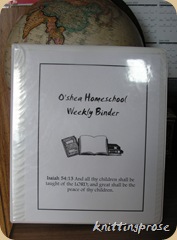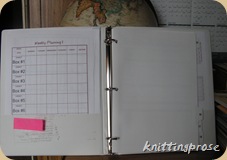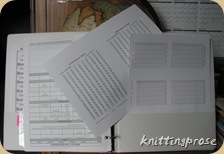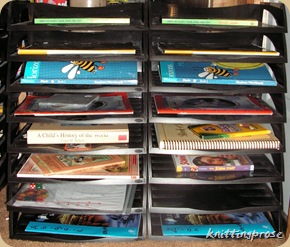
Getting back to my two favorite homeschool subjects this week – Sonlight and Workboxes – I thought you might like to know how we’re combining the two.
Let’s jump in!
2 cores/4 kids – This coming year we will be doing Core K (with 5 and 6 year olds) and Core 3 (with 8 and 10 year olds). The youngers are not even halfway through Core k, so I’m expecting us to use the entire school year to finish. The olders will only get about halfway through Core 3, I suspect. We are adding in lots of extras to slow it down and look at things a little more in depth.
Planner sheet – I use the curriculum grid that can be found at Sue Patrick’s Workbox system website. You do need to purchase her book to access the forms. It’s basically 6 columns (for Monday – Friday and 1 Extras) and rows of 12 (one for each box). This is where I plan out a week’s worth of boxes for the olders. In boxes where their studies differ, which is rare, I just slice the box diagonally to record the two.
For the youngers, I use the Weekly Planning 1 form found in the TOS Schoolhouse Planner. There are 9 rows of boxes for the 9 Workboxes the kids will be using.
Together studies – I like to do the olders’ read alouds during the second part of the day. I have found that the kids are sharpest in the morning hours, just after breakfast. I need this time for them to complete subjects like Math and Language Arts. While they are working independently, I am able to focus on the youngers’ studies. Most of their lessons require my undivided attention.
 Weekly binder – We have a tendency to be spread across two or three weeks in the Sonlight Instructor Guide. For example, we may be on week 15 in the History books and week 14 in the read-alouds. Even if we’re in just one week I like to use a Weekly binder. The contents of the binder look like this:
Weekly binder – We have a tendency to be spread across two or three weeks in the Sonlight Instructor Guide. For example, we may be on week 15 in the History books and week 14 in the read-alouds. Even if we’re in just one week I like to use a Weekly binder. The contents of the binder look like this:
The front pocket:
- Curriculum Grid and Weekly Planner form for the current week
- Any worksheets culled for this week’s boxes
- sticky notes are stuck to the front of the pocket
The binder rings:
- The current SL IG weeks – each behind their own tab. Also behind each tab, I keep the corresponding pages of the History and Read-aloud Study guides.
The back pocket:
- attendance charts (from the TOS planner) for each child, printed two per side
- hours tracking log for each child
‘Static’ boxes – We have a few subjects that are the same every single day. I call these ‘static’ boxes. For example, the morning boxes. As I mentioned above, we pretty much keep the same subjects for the morning hours of every day. The olders always work on Bible, Language Arts and Math, first thing. I know that I need to put their study workbook, along with their bible and colored pencils, in box #1. Math and Language Arts can be switched around a little but always stay within box #s 2 – 4.
*This photo shows an example of the olders’ boxes. Their Bible workbooks are at the top. (as would their bibles and colored pencils be) Notice most of their boxes hold the same materials or items we use together in corresponding boxes.
We don’t always do the read-alouds immediately after the history books. Often, I will give them a break or fun box in between.
Assigning read-alouds and history books – I have two kids per level so I usually split up the read-alouds equally in their boxes. This is really not an important thing, just how we do it. We are still reading them together (2 kids on the same core), but both kids have something in their boxes. Sometimes, I will slip the book into one’s box and any supplements into the other’s.
For History books, I do pretty much the same as above. For example, if we are reading CHOW (Child’s History of the World), I will place the book in one box and the Book of Time with some colored pencils and scissors in the corresponding box of the other child.
Games and crafts – If I place a game in a workbox that requires two or more players, I put a notecard in the other child(s)’s box(es) to indicate they are to be playing as well. For crafts, I divide up the supplies into everyone’s boxes. It’s fun seeing them try to figure out what they are going to do by checking each other’s craft box. Sometimes, I don’t give them a specific assignment and just let them come up with their own craft from what I’ve given them. This is fun experiment and it’s interesting to see the different creations they all come up with.
I hope some of this information helps you along in your Sonlight/Workbox journey. I’ve learned so much from my web friends across the world. If you have a tip specifically for how to combine the two, please leave a comment!
Sara O’



Thanks
This is very helpful. Thank you.
This is very helpful. Thank you.